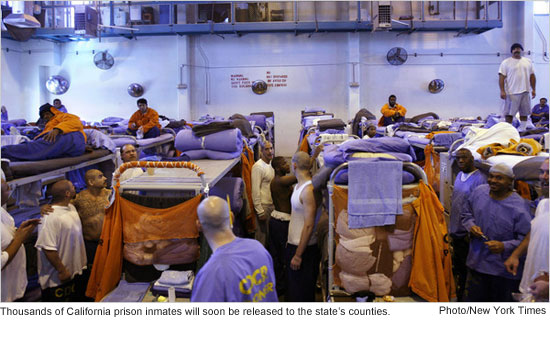State prisoners, meet your minders
July 27, 2011
 After a rare public tussle between two powerful local criminal justice agencies, the Board of Supervisors has unanimously picked the Los Angeles County Probation Department to oversee thousands of freed California prisoners who, as part of the governor’s budget plan, will no longer be charges of the state.
After a rare public tussle between two powerful local criminal justice agencies, the Board of Supervisors has unanimously picked the Los Angeles County Probation Department to oversee thousands of freed California prisoners who, as part of the governor’s budget plan, will no longer be charges of the state.
Chief Probation Officer Donald Blevins was given the nod over Sheriff Lee Baca, who had forcefully argued that his department was better suited to monitor an estimated 8,000 inmates who’ll be heading back to the streets of Los Angeles County during a nine-month period.
Critics of Baca’s proposal argued that such sweeping new duties would create public confusion over the mission of a department charged largely with suppressing crimes, not rehabilitating those who commit them. In Los Angeles and throughout the state, that job traditionally has been the responsibility of probation and parole agencies.
The board’s decision on Tuesday was based on a motion by Supervisors Michael D. Antonovich and Don Knabe, who noted that the Probation Department “has been providing supervision and rehabilitative services to adult probationers for over a century.” For that reason, they said, the agency has the kind of infrastructure and expertise that makes it best qualified to run the so-called “post-release community supervision program.” But the supervisors also called for a role for the Sheriff’s Department in identifying and, when necessary, apprehending high-risk parolees in the program.
The truth is that county officials at all levels wish they’d never had to confront the issue in the first place. Earlier this year, they argued strongly against being forced to take responsibility for the freed inmates, a key facet of Gov. Jerry Brown’s “realignment” budget strategy to save money and reduce prison overcrowding. Faced with the county’s fears about funding and strains on a local jail system already tearing at the seams, the state agreed to pay for the first year but has yet to fulfill its promises for funding beyond that.
The ex-inmates, whose releases are scheduled to begin October 1, are known as “non, non, nons”—meaning non-violent, non-serious, non-sex offenders. Under a new state law, those who violate the terms of their release will no longer be returned to state prisons. With few exceptions, they’ll serve a maximum of 180 days in county jails.
That same law also mandates that counties create an operational plan—including staffing, budget needs and re-entry services—through new multi-agency Community Corrections Partnerships. In L.A. County, the CCP will submit a plan to the Board of Supervisors for approval in August, one that is likely to include a role for the Sheriff’s Department.
Indeed, during Tuesday’s meeting Baca made clear that his department would not be relegated to the margins. “When it comes to managing high-risk parolees,” he said, “I’m not going to ask the chief probation officer for permission. I’m just going to do it.”
Obviously irritated, Baca also criticized Blevins for statements in a report to the chief executive officer in which he “literally had kind of drawn a moat around his department and looks upon me and my department as some kind of threat to the traditions of rehabilitation when, in fact, we are at the forefront of rehabilitation for parolees.”
During the meeting, Blevins, who chairs the county’ CCP, did not address Baca’s comments. But he later told the Daily News that the Sheriff’s Department would have a role in the oversight of the soon-to-arrive ex-inmates, albeit a limited one.
“Our original plan,” Blevins was quoted as saying, “was for absconders or individuals who have been working with probation but need a higher level or more intensive supervision, we would ask [the sheriff’s] assistance on those kinds of cases…The sheriff has indicated they are 24/7 and they can provide those kinds of services.”
Posted 7/27/11












 405 bridge work causes a stink
405 bridge work causes a stink
